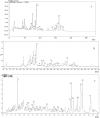Qualitative and quantitative analysis of triterpene saponins from tea seed pomace (Camellia oleifera Abel) and their activities against bacteria and fungi
- PMID: 24914901
- PMCID: PMC6271494
- DOI: 10.3390/molecules19067568
Qualitative and quantitative analysis of triterpene saponins from tea seed pomace (Camellia oleifera Abel) and their activities against bacteria and fungi
Abstract
A method using LC-ESI-IT-TOF/MS and LC/UV-ELSD was established to qualitatively analyze triterpene saponins obtained from the tea seed pomace (Camellia oleifera Abel). In addition, the quantitative analysis of oleiferasaponin A1 using LC/UV was developed. The purified total saponins did not exhibit any inhibitory effects at concentrations ranging from 0.1 to 10 mg/mL against the tested bacteria, except for Staphyloccocus aureus and Escherichia coli. By contrast, higher inhibitory activity was seen against the tested fungi, especially against Bipolaris maydis. Following treatment with an MIC value of 250 μg/mL for 24 h, the mycelial morphology was markedly shriveled in appearance or showed flattened and empty hyphae, with fractured cell walls, ruptured plasmalemma and cytoplasmic coagulation or leakage. These structural changes hindered the growth of mycelia.
Conflict of interest statement
The authors declare no conflict of interest.
Figures






Similar articles
-
Triterpene saponins from tea seed pomace (Camellia oleifera Abel) and their cytotoxic activity on MCF-7 cells in vitro.Nat Prod Res. 2021 Aug;35(16):2730-2733. doi: 10.1080/14786419.2019.1656625. Epub 2019 Aug 23. Nat Prod Res. 2021. PMID: 31441665
-
Cytotoxic and Hypoglycemic Activity of Triterpenoid Saponins from Camellia oleifera Abel. Seed Pomace.Molecules. 2017 Sep 21;22(10):1562. doi: 10.3390/molecules22101562. Molecules. 2017. PMID: 28934101 Free PMC article.
-
A new saponin from tea seed pomace (Camellia oleifera Abel) and its protective effect on PC12 cells.Molecules. 2012 Oct 1;17(10):11721-8. doi: 10.3390/molecules171011721. Molecules. 2012. PMID: 23027372 Free PMC article.
-
Triterpenoid saponins from the genus Camellia: structures, biological activities, and molecular simulation for structure-activity relationship.Food Funct. 2018 Jun 20;9(6):3069-3091. doi: 10.1039/c8fo00755a. Food Funct. 2018. PMID: 29888775 Review.
-
Advances in Separation, Biological Properties, and Structure-Activity Relationship of Triterpenoids Derived from Camellia oleifera Abel.J Agric Food Chem. 2024 Mar 6;72(9):4574-4586. doi: 10.1021/acs.jafc.3c09168. Epub 2024 Feb 22. J Agric Food Chem. 2024. PMID: 38385335 Review.
Cited by
-
Discovery of New Triterpenoids Extracted from Camellia oleifera Seed Cake and the Molecular Mechanism Underlying Their Antitumor Activity.Antioxidants (Basel). 2022 Dec 21;12(1):7. doi: 10.3390/antiox12010007. Antioxidants (Basel). 2022. PMID: 36670869 Free PMC article.
-
Insecticidal Activity and Insecticidal Mechanism of Total Saponins from Camellia oleifera.Molecules. 2019 Dec 10;24(24):4518. doi: 10.3390/molecules24244518. Molecules. 2019. PMID: 31835551 Free PMC article.
-
Cytotoxic endophyte from Camellia oleifera Abel - Penicillium chermesinum NR121310.Mycology. 2019 Dec 18;11(4):316-321. doi: 10.1080/21501203.2019.1705928. Mycology. 2019. PMID: 33329927 Free PMC article.
-
Quantitative Analysis of Camellia oleifera Seed Saponins and Aqueous Two-Phase Extraction and Separation.Molecules. 2023 Feb 24;28(5):2132. doi: 10.3390/molecules28052132. Molecules. 2023. PMID: 36903377 Free PMC article.
-
The mechanism of Andrena camellia in digesting toxic sugars.iScience. 2024 Apr 29;27(6):109847. doi: 10.1016/j.isci.2024.109847. eCollection 2024 Jun 21. iScience. 2024. PMID: 38840840 Free PMC article.
References
-
- Huang H.Q., Zhang X., Xu Z.X., Su J., Yan S.K., Zhang W.D. Fast determination of saikosaponins in Bupleurum by rapid resolution liquid chromatography with evaporative light scattering detection. J. Pharm. Biomed. 2009;49:1048–1055. - PubMed
-
- Hu J.L., Nie S.P., Huang D.F., Li C., Xie M.Y. Extraction of saponin from Camellia oleifera cake and evaluation of its antioxidant activity. Int. J. Food Sci. Technol. 2012;47:1676–1687.
Publication types
MeSH terms
Substances
LinkOut - more resources
Full Text Sources
Other Literature Sources

